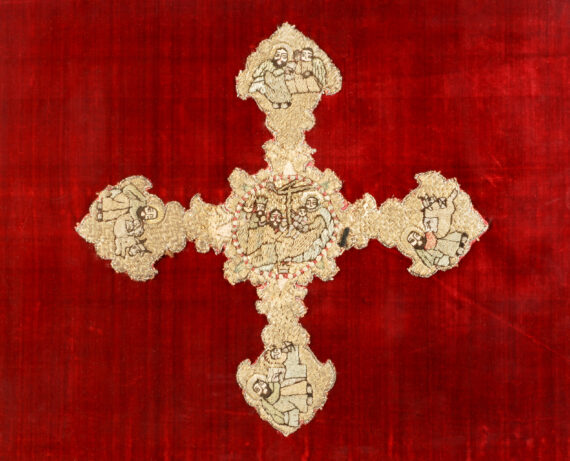PART OF LITURGICAL VESTMENT
Velvet and silk, 19th Century
PART OF LITURGICAL VESTMENT
Velvet and silk, 19th Century
L 230mm
Cross embroidered with gold and silk threads. In its centre the Adoration of the Magi, and on the edges the four evangelists with their symbols.
The Gospel according to Saint Matthew. Chapter 2.
Now behold, wise men from the East came to Jerusalem saying: “Where is He who has been born King of the Jews?
For we have seen his star in the East and have come to worship Him.""
When Herod heard this, he was troubled, and all Jerusalem with him.
And when he had gathered all the chief priests and scribes of Israel, he inquired of them where the Christ was to be born.
So they said to him: “In Bethlehem of Judea, for thus it is written by the prophet:
“But you, Bethlehem, in the land of Judah, are not the least among the rulers of Judah.
For out of you shall come a ruler who will shepherd my people Israel.
Then Herod, when he had secretly called the wise men, determined from them what time the star appeared. And he sent them to Bethlehem and said:
“Go and search carefully for the young Child,
And when you have found Him, bring back word to me, that I may come and worship Him also.”
And behold, the star which they had seen in the East went before them,
till it came and stood over where the young Child was.
When they saw the star, they rejoiced with exceedingly great joy.
They saw the young Child with Mary His mother, and fell down and worshipped Him.
And when they had opened their treasures, they presented gifts to Him: gold, frankincense, and myrrh.
Then, being divinely warned in a dream that they should not return to Herod, they departed for their own country another way.
There was no shortage of raw materials: wool from the mountains, cotton from the valleys, silk, first from China and later cultivated on the plateau, or red carmine dye from the cochineal insect.
A textile craft industry for use by people and their homes was necessary to counter the harsh and contrasting weather conditions.
The Armenians quickly acquired a reputation for their skill. “They weave the finest and most beautiful carpets in the world"", wrote Marco Polo in the 13th century.
Long before that, however, Greek and Arab historians spoke of Armenian carpets often given as gifts or that formed part of the spoils of war paid to the victors.
Embroideries on silk, velvet, cotton or wool, had very similar patterns to those of the carpets. There are animal, vegetable or geometrical motifs.
The lace ""oya"" is also an integral part of the textile arts. In the form of bands or little mats with radiating, cruciform or geometrical patterns, they are used to adorn secular or liturgical clothing, or to decorate the churches.
Embroidery and lace are also used to decorate the simplest clothes and are not reserved for luxury items as they are elsewhere.
Every woman in an Armenian household is skilled in needlework and the tradition is passed on from one generation to the next with the bride's trousseau.
Fabrics and embroideries, enhanced with silver ornaments and jewels adorn costumes, especially those of women, in Armenia. The men, who many times have found themselves in the minority of their country of residence, have often preferred to adapt to local dress customs, while the women, at home, have perpetuated the tradition of Armenian costume.
Frédéric Fringhian
Although Jesus left no written testimony, witnesses recounted his actions and reported his words. The four best-known witnesses are the four evangelists, Matthew, Mark, Luke and John. Their texts were written during the century following the birth of Christ. They are not all identical and do not report the same events. The first one, that of Mark, dates from the year 67. The texts of Matthew and Luke were written around the year 80, and John wrote his work almost 70 years after the birth of Christ.
